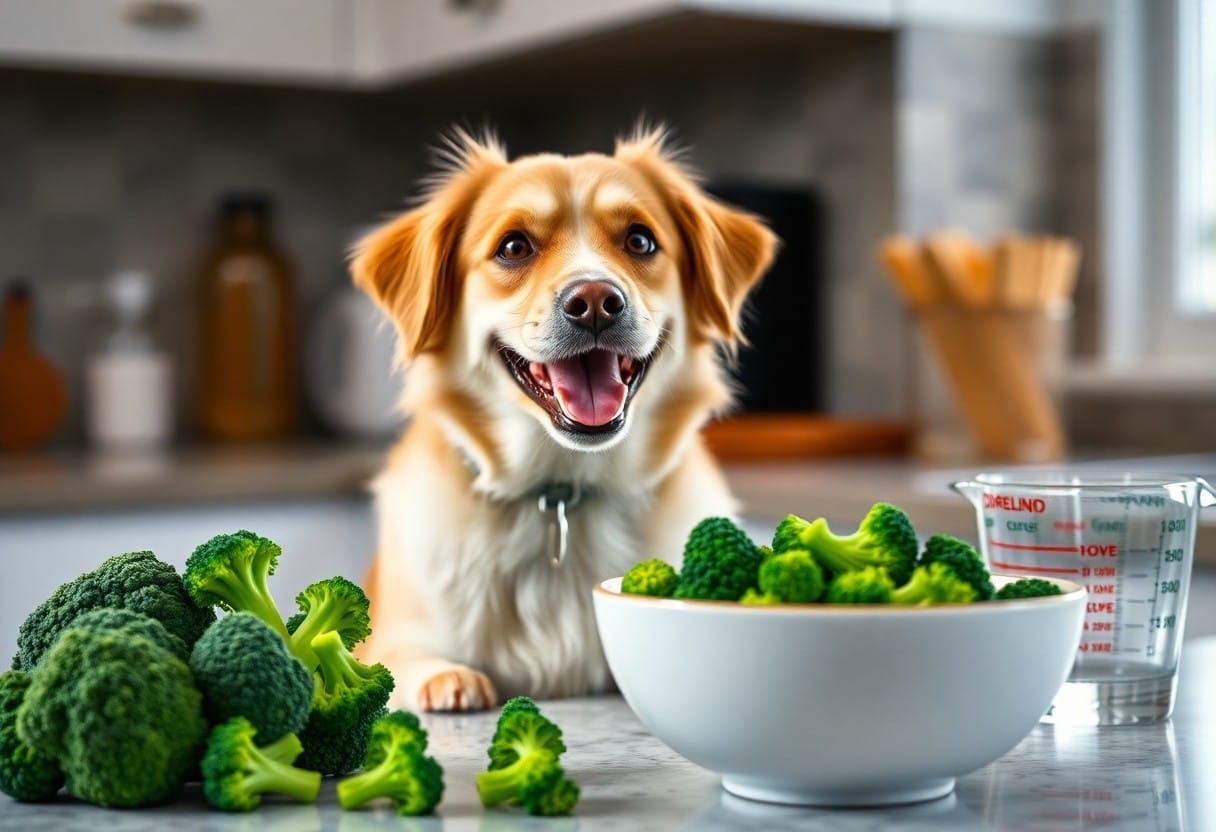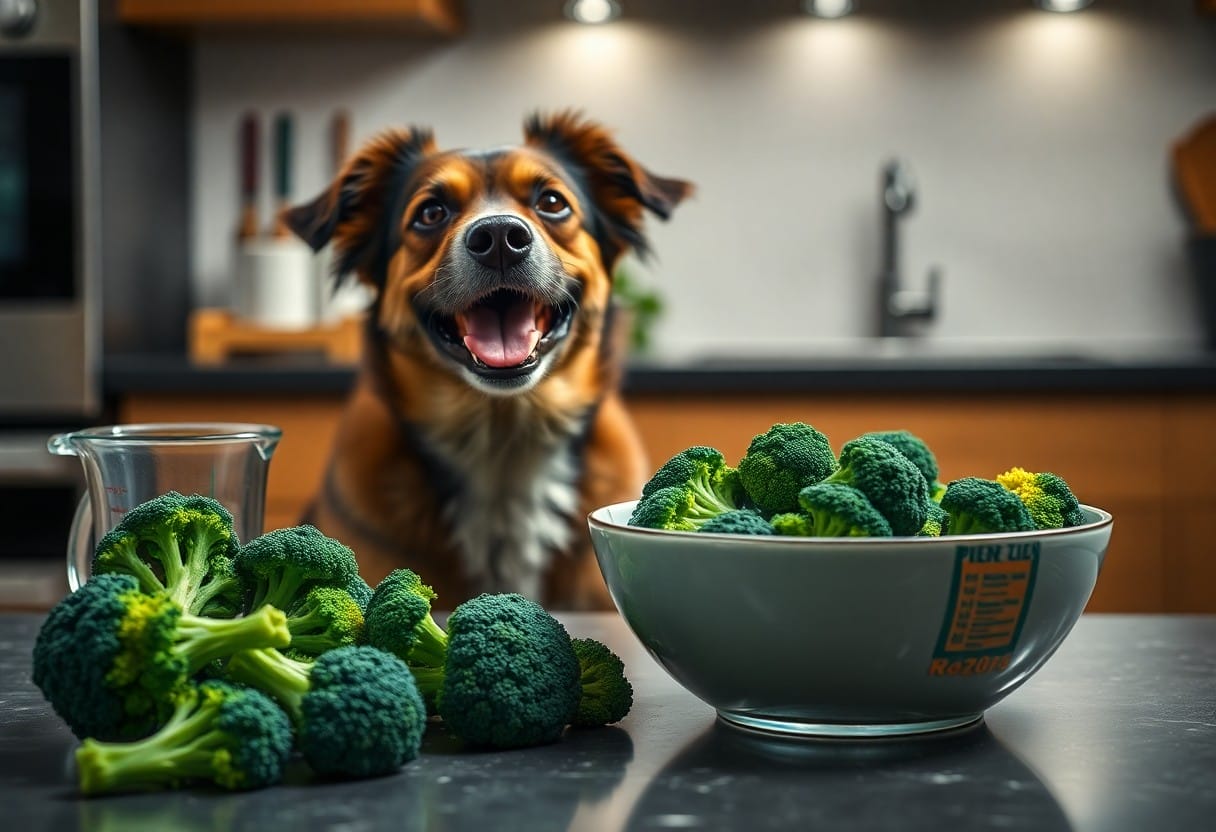
How to Safely Include Broccoli in Your Dog’s Diet?
Share
Over time, you may have wondered if broccoli could be a healthy addition to your dog's meals. While this nutrient-rich vegetable offers numerous benefits, including vitamins and antioxidants, it's important to know how to include it safely. Certain parts of broccoli can be toxic in large quantities, especially for smaller dogs, leading to gastrointestinal issues. In this guide, you'll learn the correct way to introduce this green superfood into your dog's diet, ensuring they enjoy the benefits while avoiding any potential hazards.

Key Takeaways:
- Preparation: Always steam or cook broccoli to make it easier for your dog to digest, as raw broccoli can be hard on their stomach.
- Moderation: Introduce broccoli slowly into your dog's diet and only offer it as an occasional treat to avoid potential digestive issues.
- Check for Reactions: Monitor your dog for any adverse reactions after consuming broccoli, particularly for symptoms like gas or stomach upset.
Understanding Broccoli Safety for Dogs
Your dog's health and safety should always come first, especially when introducing new foods like broccoli. While this vegetable can offer numerous benefits, it's vital to understand how to incorporate it safely into your dog's diet to avoid any adverse effects.
Toxicity Factors to Consider
Factors to keep in mind when adding broccoli to your pup's nutrition include:
- Isothiocyanates: Can be harmful in excessive amounts.
- Digestive Issues: Some dogs may experience gas or upset stomach.
- Individual Sensitivity: Monitor your dog for allergic reactions or intolerance.
Any changes in your dog's behavior or health should prompt a consultation with your vet.
Safe Serving Sizes
If you are considering adding broccoli to your dog's diet, it's important to start small. A general rule is to offer no more than 10% of your dog's daily caloric intake from treats, including broccoli. Keep portions modest initially, like a few small florets, to assess how your dog reacts.
Consider introducing broccoli gradually, starting with just a few small pieces to see how your dog adapts. Monitor for any signs of upset stomach or gas, as these can indicate intolerance. If your dog enjoys broccoli without adverse effects, you might gradually increase to one or two florets per serving. Overall, focus on moderation, as large amounts can lead to digestive strain. Always consult with your veterinarian if unsure about your dog's specific dietary needs.
Preparing Broccoli for Canine Consumption
Clearly, when introducing broccoli to your dog's diet, it's crucial to prepare it properly to ensure your pet can digest it safely. You should steam or cook the broccoli to make it easily digestible for your dog.
Cooking Methods for Optimal Nutrition
Methodically, you can steam or boil broccoli to preserve its nutritional value. This will help break down the cell walls, making it easier for your dog to absorb the crucial vitamins and minerals.
How to Avoid Choking Hazards
Cooking broccoli until it's tender is vital to prevent choking hazards. You should chop it into small pieces to minimize the risk of your dog choking on large florets.
Plus, when preparing broccoli for your dog, you should be aware of the potential risks of overfeeding, which can lead to gastrointestinal upset. As you introduce broccoli to your dog's diet, monitor their behavior and stool quality closely, and adjust the amount accordingly to ensure a healthy and balanced diet for your pet.
Health Benefits of Broccoli for Dogs
Nutritional Value and Vitamins
Healthy amounts of vitamins and minerals are present in broccoli, which can provide necessary nutrients for your dog's overall health and wellbeing, making it a great addition to their meals.
How Broccoli Can Support Canine Health
Assuming you introduce broccoli to your dog's diet gradually, you can expect to see improved health benefits, including reduced inflammation and stronger immunity. As you learn more about the benefits of broccoli for your dog, you will be able to make informed decisions about their diet.
Benefits of feeding your dog broccoli include cancer prevention, improved digestive health, and reduced allergy symptoms. As you consider adding broccoli to your dog's meals, keep in mind that overconsumption can be toxic to your pet, so moderation is key to safe and healthy consumption.

How-To Guide to Adding Broccoli to Your Dog's Diet
Despite the potential benefits, introducing broccoli to your dog's diet requires caution. You'll need to follow a careful plan to ensure a safe and healthy experience for your pet.
Tips for Gradual Introduction
Any introduction to new foods should be done gradually. Consider the following:
-
- Start with small amounts of steamed broccoli
- Monitor your dog's digestive health
The key to successful introduction is patience and close observation of your dog's behavior.
Monitoring Your Dog's Reaction
Your dog's reaction to broccoli will be unique, so it's imperative to watch for signs of discomfort or allergy, such as diarrhea or vomiting.
It is vital to keep a close eye on your dog's behavior and health indicators, as negative reactions can occur. You should be aware of the potential risks and take immediate action if you notice any adverse effects. By doing so, you can ensure a safe and healthy experience for your pet.

Important Factors to Consider
Unlike other vegetables, including broccoli in your dog's diet requires careful attention to specific factors. Consider the following:
-
-
- Size of the dog
- Preparation method
- Portion control
- Existing health conditions
- Allergies
-
Always consult your veterinarian before introducing new foods.
Perceiving these factors properly can ensure your dog enjoys broccoli safely.
Allergies and Sensitivities
Important to note that some dogs may have allergies or sensitivities to broccoli. Common symptoms include itching, digestive issues, or other allergic reactions. Always introduce broccoli gradually into your dog's diet and monitor for any adverse reactions.
Interactions with Medications
You should be aware that certain foods, including broccoli, can interact with medications your dog may be taking. Consult your veterinarian if your dog is on medications to discuss any potential interactions to ensure their health and safety.
For instance, some medications, particularly those affecting blood clotting or metabolism, may have altered effects when combined with broccoli. This can lead to either diminished efficacy or increased side effects. Always ensure your vet is informed about all aspects of your dog's diet, including safe vegetable options like broccoli, to avoid unforeseen complications.
Common Mistakes to Avoid
All dog owners want the best for their pets, but when it comes to adding broccoli to their diet, there are pitfalls to watch out for. You should be aware of the potential risks to ensure your dog's safety and well-being.
Overfeeding and Digestive Issues
Now that you're considering adding broccoli to your dog's diet, be cautious not to overfeed them, as this can lead to severe digestive issues, including diarrhea and vomiting.
Inadequate Preparation
Little do you know, the way you prepare broccoli can greatly impact your dog's health, so it's imperative to properly clean and cook the vegetable to avoid any harmful effects.
This is especially important because raw or undercooked broccoli can contain toxic compounds that can be harmful to your dog. You should always steam or cook the broccoli to break down these compounds and make it safe for consumption, allowing your dog to benefit from its nutritional value.
Final Words
So, when introducing broccoli to your dog's diet, you must do so in moderation. You should start with small amounts to avoid digestive issues. As you monitor your dog's reaction, you can adjust the serving size. By following these guidelines, you can ensure a safe and healthy addition to your dog's meals, providing them with the nutritional benefits of broccoli.
FAQ
Q: Can I give my dog broccoli as a regular treat?
A: While broccoli can be a nutritious and healthy snack for dogs, it's vital to introduce it in moderation. Broccoli contains a compound called isothiocyanate, which can be toxic to dogs in large quantities. Start by offering small amounts (about 1/4 cup per 10 pounds of body weight) and monitor your dog's reaction. If you notice any adverse effects, such as digestive upset or allergic reactions, discontinue use.
Q: How should I prepare broccoli for my dog to eat?
A: To minimize the risk of digestive upset, it's best to cook broccoli before serving it to your dog. Steaming or lightly cooking broccoli can help break down the cell walls, making it easier for your dog to digest. Avoid adding any seasonings, oils, or butter, as these can be toxic to dogs. Plain, cooked broccoli is the safest option. You can also puree cooked broccoli and add it to your dog's regular meals.
Q: Are there any health benefits to including broccoli in my dog's diet?
A: Yes, broccoli is rich in vitamins, minerals, and antioxidants that can provide several health benefits for dogs. Broccoli contains fiber, which can help support healthy digestion, and vitamins C and K, which can help boost the immune system. Additionally, broccoli contains a group of compounds called glucosinolates, which have been shown to have anti-inflammatory properties and may help protect against certain cancers.
Q: Can puppies eat broccoli, or is it only suitable for adult dogs?
A: Puppies can eat broccoli, but it's vital to introduce it slowly and in small amounts. Puppies have sensitive digestive systems, and sudden changes to their diet can cause stomach upset. Start by offering tiny amounts (about 1/8 cup per 10 pounds of body weight) and gradually increase the amount as your puppy becomes accustomed to it. Always consult with your veterinarian before making any changes to your puppy's diet.
Q: What are the signs of broccoli toxicity in dogs, and what should I do if I suspect my dog has eaten too much broccoli?
A: If your dog has eaten too much broccoli, it may exhibit signs of gastrointestinal upset, such as vomiting, diarrhea, or abdominal pain. In severe cases, broccoli toxicity can cause more severe symptoms, including lethargy, tremors, or difficulty breathing. If you suspect your dog has eaten too much broccoli, seek veterinary attention immediately. Your veterinarian may induce vomiting, administer activated charcoal, or provide supportive care to manage symptoms and prevent further complications.
